Types of macromolecules - Study guides, Class notes & Summaries
Looking for the best study guides, study notes and summaries about Types of macromolecules? On this page you'll find 1905 study documents about Types of macromolecules.
All 1.905 results
Sort by
 Popular
Popular
-
Testbank for Biology 2nd Edition from OpenStax College
- Exam (elaborations) • 57 pages • 2023
-
- $17.99
- 5x sold
- + learn more
Testbank for Biology 2nd Edition from OpenStax CollegeChapter 1 1 Figure 1.6 1: C; 2: F; 3: A; 4: B; 5: D; 6: E. The original hypothesis is incorrect, as the coffeemaker works when plugged into the outlet. Alternative hypotheses include that the toaster might be broken or that the toaster wasn't turned on. 3 Figure 1.16 Communities exist within populations which exist within ecosystems. 4 B 6 D 8 C 10 C 12 B 14 D 16 Answers will vary, but should apply the steps of the scientific method. One poss...
 Popular
Popular
-
Testbank for Biology 2nd Edition from OpenStax College
- Exam (elaborations) • 57 pages • 2023 Popular
-
- $17.99
- 1x sold
- + learn more
Testbank for Biology 2nd Edition from OpenStax Collegeable of Contents Chapter 1 ................................................................................................................................. 2 Chapter 2 ................................................................................................................................. 2 Chapter 4 ................................................................................................................................. 5 Cha...
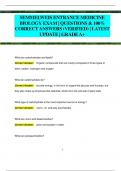
-
SEMMELWEIS ENTRANCE MEDICINE BIOLOGY EXAM | QUESTIONS & 100% CORRECT ANSWERS (VERIFIED) | LATEST UPDATE | GRADEA+
- Exam (elaborations) • 28 pages • 2024
-
- $10.49
- 1x sold
- + learn more
SEMMELWEIS ENTRANCE MEDICINE BIOLOGY EXAM | QUESTIONS & 100% CORRECT ANSWERS (VERIFIED) | LATEST UPDATE | GRADEA+ What are carbohydrates and lipids? Correct Answer: Organic compounds that are mostly composed of three types of atom; carbon, hydrogen and oxygen What do carbohydrates do? Correct Answer: provide energy, in the form of sugars like glucose and fructose, but they also make up structures like cellulose, which form the cell wall of plant cells What type of carbohydrate is...

-
Biology 0100 Final Exam CSCC Dr. Cronk Questions And Answers Rated A+
- Exam (elaborations) • 10 pages • 2024
- Available in package deal
-
- $7.99
- 1x sold
- + learn more
Abiotic - Non-living acid deposition (acid rain) - Release of sulfate and nitrate during theburning of coal contributes to ___________ Age of Angiosperms - Cenozoic Era 125 million years ago Age of Gymnosperms - Became the dominant plants. The Mesozoic is sometimes called the Age of Cycads. But their success was short-lived. . 390 million years ago Age of Mammals - Cenozoic Era- dinosaurs were gone. They began to flourish 65 million years ago Age of Reptiles - Mesozoic Era- dinosaurs r...
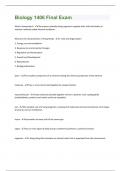
-
Biology 1406 Final Exam | 715 Questions and Answers(A+ Solution guide)
- Exam (elaborations) • 68 pages • 2023
- Available in package deal
-
- $13.49
- 1x sold
- + learn more
What is homeostasis - the process whereby living organisms regulate their cells and bodies to maintain relatively stable internal conditions What are the characteristics of living things - 1. Cells and Organization 2. Energy use and metabolism 3. Response to environmental changes 4. Regulation and homeostasis 5. Growth and Development 6. Reproduction 7. Biological Evolution atom - the smallest component of an element having the chemical properties of the element molecule - Two or more ...

-
TAMU BIOL 111 FLETCHER FINAL EXAM WITH VERIFIED SOLUTIONS ALREADY GRADED A+
- Exam (elaborations) • 36 pages • 2023
- Available in package deal
-
- $14.99
- 1x sold
- + learn more
describe the basic functions all life forms must accomplish -response to environmental stimuli & maintain homeostasis -uptake and processing of nutrients/energy -regulation -growth and reproduction compare and contrast eukaryotic and prokaryotic cell types Prokaryotes: -circular chromosomes, no nucleus, no organelles, 3.5 bya -DNA concentrated in nucleoid Eukaryotes: -linear chromosomes, nucleus, organelles, 1.5 bya -DNA concentrated in nucleus Both: -cellular function takes p...
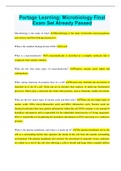
-
Portage Learning: Microbiology Final Exam Set Already Passed
- Exam (elaborations) • 40 pages • 2022
- Available in package deal
-
- $10.49
- 19x sold
- + learn more
Portage Learning: Microbiology Final Exam Set Already Passed Microbiology is the study of what? Microbiology is the study of microbes (microorganisms and viruses) and their biological processes. What is the smallest biological unit of life? A cell What is a macromolecule? A macromolecule is classified as a complex molecule that is composed from smaller subunits. What are the four main types of macromolecules? Proteins, nucleic acids, lipids and carbohydrates What various functions do protein...
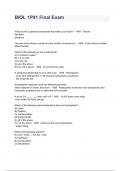
-
BIOL 1P91 Final Exam Questions And Verified Solutions
- Exam (elaborations) • 15 pages • 2023
- Available in package deal
-
- $11.99
- 1x sold
- + learn more
BIOL 1P91 Final Exam Questions And Verified Solutions What are the 3 general components that make up an atom? - ANS Protons Neutrons Electrons The sum of the atomic number and the number of neutrons is: - ANS A (the atomic number) Mass Number Which of the following is/ are a polar bond? A) O-H bond in water * B) C-O in CO2 C) N-N in N2 D) all of the above E) two of the above - ANS A) O-H bond in water A substance dissolvable in oil is said to be: - ANS Hydrophobic...

-
C190 WGU Biology exam 2023 with 100% correct answers
- Exam (elaborations) • 8 pages • 2023
- Available in package deal
-
- $13.49
- 1x sold
- + learn more
Biological macromolecules formed when atoms of carbon, hydrogen, oxygen, nitrogen, phosphorus, and other elements bond with each other in unique and varied ways Atom building blocks of all matter four classes of biological macromolecules carbohydrates, lipids, proteins, and nucleic acids cell fundamental, basic unit of life Matter anything that occupies space and has mass Subatomic Particles of Atom protons, neutrons, and electrons Electrons Subat...

-
BIOD 171 Portage Learning Final Exam Review questions with Complete Solutions rated A+
- Exam (elaborations) • 25 pages • 2024
- Available in package deal
-
- $7.99
- 1x sold
- + learn more
True/False. A virus is considered a microorganism. - False, Viruses are not living and as such are not considered microorganisms. Viruses can, however, be classified as microbes, a more general term that includes microorganisms and viruses. What is the smallest biological unit of life? - A cell What are the four main types of macromolecules found in cells? - Proteins, Lipids, Nucleic Acids, Carbohydrates Proteins are formed from various combinations of - Amino acids There are how many kno...
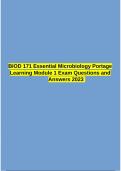
-
BIOD 171 Essential Microbiology Portage Learning Module 1 Exam Questions and Answers 2023
- Exam (elaborations) • 11 pages • 2023
-
- $11.49
- 1x sold
- + learn more
BIOD 171 Essential Microbiology Portage Learning Module 1 Exam Questions and Answers 2023 BIOD 171 M1: Module 1 Exam - Requires Respondus LockDown Browser + Webcam Question 1 3 / 3 pts True/False. A virus is classified as a microbe. Correct! True Although viruses are not living and as such are not considered microorganisms, they can, however, be classified as microbes, a more general term that includes microorganisms and viruses. False Question 2 3 / 3 pts True or False: The...

-
BIOD 171 Portage Learning Final EXAM Questions and Answers 100%Correct/Exam 1-7 2023/2024 Update
- Exam (elaborations) • 44 pages • 2023
-
- $20.99
- 5x sold
- + learn more
BIOD 171 Portage Learning Final EXAM Questions and Answers 100%Correct/Exam 1-7 2023/2024 UpdatePortage Learning BIOD 171 Final EXAM Questions and Answers 100%Correct/Exam 1-7 2023/2024 Update True or False: A virus is considered a microorganism. False. Viruses are not living and as such are not considered microorganisms. Viruses can, however, be classified as microbes, a more general term that includes microorganisms and viruses. 1. What is the smallest biological unit of life? A cell. ...

Study stress? For sellers on Stuvia, these are actually golden times. KA-CHING! Earn from your study resources too and start uploading now. Discover all about earning on Stuvia


